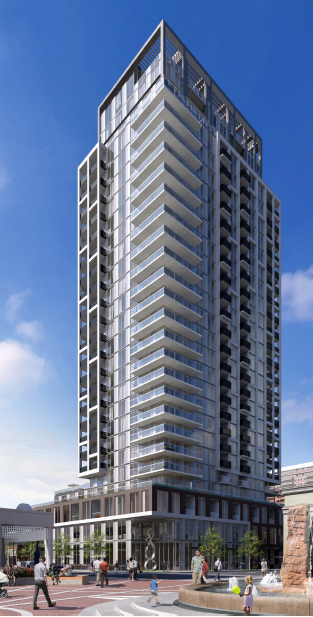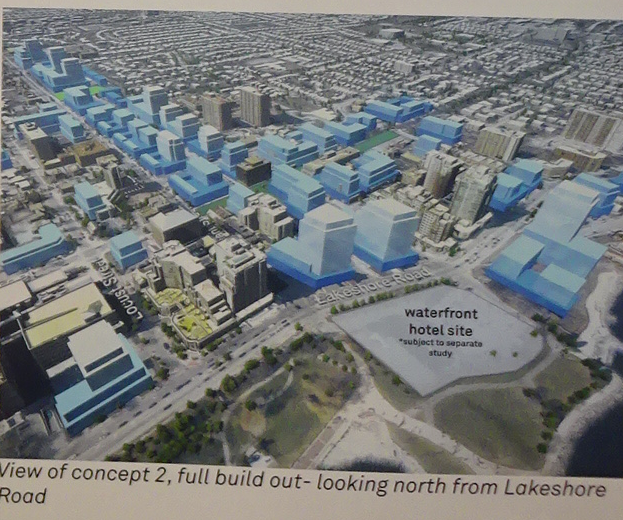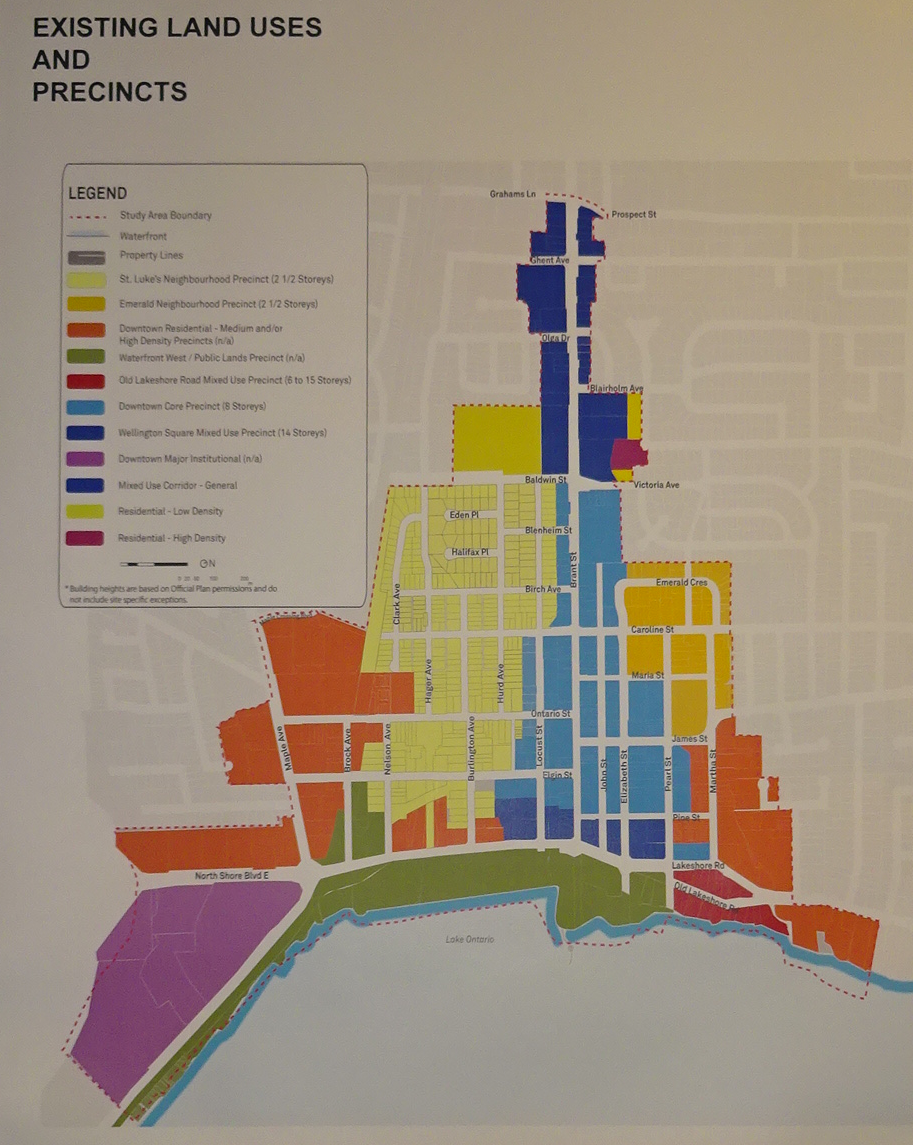 By Pepper Parr
By Pepper Parr
September 25, 2017
BURLINGTON, ON
Part 1 of a four part series on the city’s Grow Bold initiative.
When a developer takes an application to the Planning department there are close to a dozen different studies that have to be provide an Urban Design Brief, Noise Study, Shadow Impact Assessment, Pedestrian Wind Assessment, Transportation Impact Study, Parking Study and TDM Options, Functional Servicing Report,
Environmental Site Screening Questionnaire, Geotechnical Engineering Report, Hydrogeological Investigation Report and a Phase 1 Environmental Site Assessment
 Some developers engage a consultant to provide an opinion on the relevance of the development and how it will impact and fit into the long term plans the city has. It is not unusual for a report from a consultant to question some of the information the city has published and to offer a different analysis of the data.
Some developers engage a consultant to provide an opinion on the relevance of the development and how it will impact and fit into the long term plans the city has. It is not unusual for a report from a consultant to question some of the information the city has published and to offer a different analysis of the data.
These reports are a healthy part of the city building process.

Architectural rendering of a proposed 26 storey tower across Brant Street from city hall.
The Carriage Gate group has an application for a proposed 26 storey mixed use development with 179 residential condominium units, street-related retail uses and second storey office space.
At times these reports don’t get public exposure – they aren’t secret but sometimes they don’t get a solid public debate, which is unfortunate for the report that was prepared by the Altus Group, an economic consulting organization that was retained by 421 Brant Street Inc., to offer a different perspective, sets out just what they think the city is looking at with its Grow Bold initiative.
The report runs more than 60 pages and it is complex but there is some very solid evidence that we feel should be available to the public.
If you care about what happens to your city and the kind of growth it is going to go through in the next two decades read on. We set out the views expressed by the consultants with some analysis as to just what this is going to mean in a larger context.
The Altus report explains the development in relation to the various pieces of provincial and municipal planning policies applicable to Burlington.
The intensification Burlington is going through is determined first by the province that determines where future growth should go and then assign a population number to each part of the province.
The Halton Region Official Plan allocates 8,086 new units to be achieved in the built-up area of Burlington over the 2017 to 2031 period.
According to Altus, on an annual basis, the target is 33% higher than the amount of intensification achieved in Burlington over the 2006 to 2016 period.
They add that the scale of the high density building proposed for 421 Brant Street is modest relative to the Halton Region target.
 Then they add this astonishing statement:
Then they add this astonishing statement:
At least 45 new buildings of similar scale would be needed within the built-up area of Burlington over the 2017 to 2031 period to achieve the 8,086 new units required under the Halton Region Official Plan.
That is an astounding statement that doesn’t seem to have seeped into the public debate even though every member of Council was given a copy of the report. The Planning department has copies and they aren’t likely to ignore a report from a firm with the enviable Altus Group reputation.

The city has broken the downtown core into precincts and set height levels for each. These have yet to be approved by city council.
Provincial and municipal planning policies require that a significant share of Burlington’s population growth and residential intensification occur in the Downtown Burlington urban growth centre. Those same policies require that the Downtown urban growth centre achieve a minimum density target of at least 200 residents and or jobs per hectare by 2031 or earlier.
The 2017 Growth Plan allocates 220,000 more residents to Halton Region by 2041, over and above the 780,000 residents provided for in the current Halton Region Official Plan. The minimum intensification targets in the 2017 Growth Plan are substantially higher than the minimum intensification targets in the Halton Region Official Plan.
Over the period leading up to the next Regional municipal comprehensive review, optimizing the use of land in locations that offer convenient access to jobs, stores and services, transportation options and public service facilities will help set the stage for the accommodation of the additional amounts of intensification required under the 2017 Growth Plan.
The residential component of the 421 Brant development is to include:
• 34 one bedroom units;
• 108 two bedroom units; and
• 37 three bedroom units.
The Altus report examines the economic and housing implications of the proposed development in the context of provincial and municipal planning policies. They don’t make a recommendation – they just lay out the facts as they read them and point out the implications.



















I find it interesting that people get upset about construction of a condo tower in downtown of Burlington which is close to shopping, transit, the lake, parks, schools etc. Yet these people seem completely fine with greenfield tract housing that is built in the north of the city. These developments seem to be built entirely around big box stores, massive parking lots and 6 lane busy streets. What is going to happen when these retailers move online or change their format like they do every decade? A lot of these stores are already vacant. At least the downtown condo tower should survive the test of time and be a nice place for someone to live in 10, 20, 30 years time. If they build 45 more of these towers downtown Burlington will have a very vibrant community with schools (that are actually full), restuaruants, retail stores etc. and a place where people can walk to all of these things. I would take the tower over the tract housing any day.
I agree with almost every point made however there’s one that hasn’t been made.
The Provincial Intensification target was in part meant to promote public transit accommodative housing density. This was to reduce green house gases and add a mix of affordable housing. Fast forward to Burlington and as evidenced by the COW counsel meeting on September 7th and we find out we essentially don’t have a transit plan and in fact BT will require years of intense investment to bring it to the point of sustainability.
A total failure of project management where transit is working in one silo and planning is working in another.
Frankly, if you can’t convince anyone that you can move this intensified city then you have no business adding population in the first place.
What about the other 21 proposed hi-rise developments submitted to City Hall?
Here’s my simplistic summary:
1. Anonymous bureaucrats mandate that we should grow to a specific population level by a pre-determine date.
2. Developers submit proposals that far exceed height and density levels to generate the greatest return.
3. The City don’t have the experience and legal resources to fight the developers.
4. OMB rubber stamp the developers proposals.
5. Today’s residents loose out with the loss of green space and its heritage
6. Tomorrow moves ever closer to creating a depressing concrete jungle that is downtown Toronto.
Welcome to George Orwell’s 1984!
If the provincial government were believed to be competent their intensification policies could be taken seriously, but that simply isn’t the case. “Intensification” (is there a university offering a degree in Euphemism somewhere…?) is much more complicated than simply adding some taller buildings to a community that already has limited existing infrastructure capacity simply to enrich developers.
Grow Bold = Grow Stupid. We can avoid that next year by voting out any politician who supports it.
MPP Chris Ballard
Quote
“Ballard says intensification is needed to support public transit infrastructure, but the province still wants to protect our sense of communities.”
Remember when “urban sprawl” was once thought of a beautiful bedroom communities like Burlington.
This Report is preposterous to the point of almost being laughable! What would you expect a consultant hired by a developer to report: that we don’t need more development.
As has been noted, developers have a vested interest in building more high rises, and it is called “making a profit”. They don’t care about residents. They don’t care about quality of life. They don’t care about environmental concerns, or sustainability, or traffic congestion, or lack of green space, or anything that ordinary citizens care about. Their focus is making a buck. At they end of the day they will drive home to their multi-million dollar mansions in the country and leave the rest of us to live with and/or clean up their mess.
Taxpayers don’t need a consultants’ report to tell us what the future of this City should look like. We also don’t need a sham of a consultation process with nicely branded marketing logos called “Grow Bold” to sell us on what future development should look like. What we do need are some new faces on this Council in 2018 comprised of Councillors who have principles, backbones, and the courage to say “no” to developers.
This should come as a surprise to no one. There’s lots of talk about how Burlington is growing too fast, it really hasn’t been growing that quickly at all. There have only been a handful of high rises built downtown in the last fifteen years. Hardly anything to panic about. Everyone survived and many would argue our downtown is better because of this modest growth.
I’m not sure what’s so Orwellian about the term “intensification”. Our province is growing in population. That’s a fact. So where exactly would you rather have this growth go? People have to live somewhere! Why chop down forests and build more highways and box stores and parking lots, when it makes much more sense to use existing infrastructure and make our existing cities denser and more sustainable? Not everyone looks at this as undesirable. I get that not everyone likes high rises and there are arguments to be made for a more “gentle” approach to density (more townhouses, mid-rise buildings, etc.) but the intensification-leads-to-dystopia narrative is unfounded.
The idea that there are government officials sitting around laughing and nefariously plotting to get you out of your car against your will and forcing you to (gasp!) ride the bus, isn’t really how it works. Are they trying to look ahead and build smarter cities in an effort to reduce car dependency? Absolutely. And I look forward to living in such a city.
This big centralized government plan on forcing Burlington’s population to grow all in the aim of, overcrowding, otherwise known by the far more popular Orwellian term “intensification” needs to end. Especially, when I read one of the main reasons for this planned overcrowding is so that people will get out of their bourgeois cars, and onto public transportation.
From the Burlington’s grow bold. (don’t you just luv it) page: “Build Up means the city will…. embrace density… with a variety of low, medium and high rise buildings”
Are you ready to embrace planned overcrowding? Don’t you just love it when they market a bad thing into something you should, want, and embrace.
We live in the age of the “experts” who are paid well to provide the technical rationale their benefactors are looking for. “…just lay[ing] out the facts as they read them” is a highly selective exercise.
The developers and the city planners have their experts to back them up. Residents have no such advantage.
What’s at the heart of the development discussion is the money flowing towards the guns for hire. Higher aims for our community like beauty, human well-being, inclusivity, social and environmental cohesion are pushed aside in pursuit of these self-enriching agendas.
So let me get this straight, a developer seeking more than a 50% increase in height to what it is already permitted has hired a consultant that has produced a report suggesting that up to 45 26 storey buildings are required to meet target by 2031. I would take that suggestion with a massive grain of salt, and view it as not much more than a developer trying to justify a huge height and density increase.
I agree with Gary. I seem to recall something recently presented by the Planning department to City Council that noted the target could be met with the buildings that are under construction and those proposed or currently in the planning stages.
No doubt the growth Centre will need to intensify. But maybe a few tall 20 – 22 storey buildings in strategic locations, not 26 storey buildings solidly from the Lakeshore to Fairview.
While I question some of the logic used by the province to “assign” certain density and population “requirements” to Halton and ultimately Burlington, I find no panic building required to meet the 2017 – 2031 targets.
The estimated 33% higher Burlington intensification required for 2017 – 2031 over 2006 – 2017 is not a burning issue. If I do the math, the 2006 – 2016 inclusive period is 11 years. The 2017 – 2031 inclusive period is 15 years. 15 divided by 11 is 36% higher. So the pace of intensification set in the 2017 – 2031 period needs to be no higher than that met in the 2006 – 2016 period.
The finger can be removed from the panic button. Thoughtful planning and building can continue at the pace already set. But it needs to be put in perspective. The current pace was achieved while still building many detached homes north of Dundas Street that work against intensification. That option will end soon as the build out there completes. Then it becomes higher density buildings only to satisfy the targets. I think this can be attained without any 20 plus storey buildings in the growth centres.